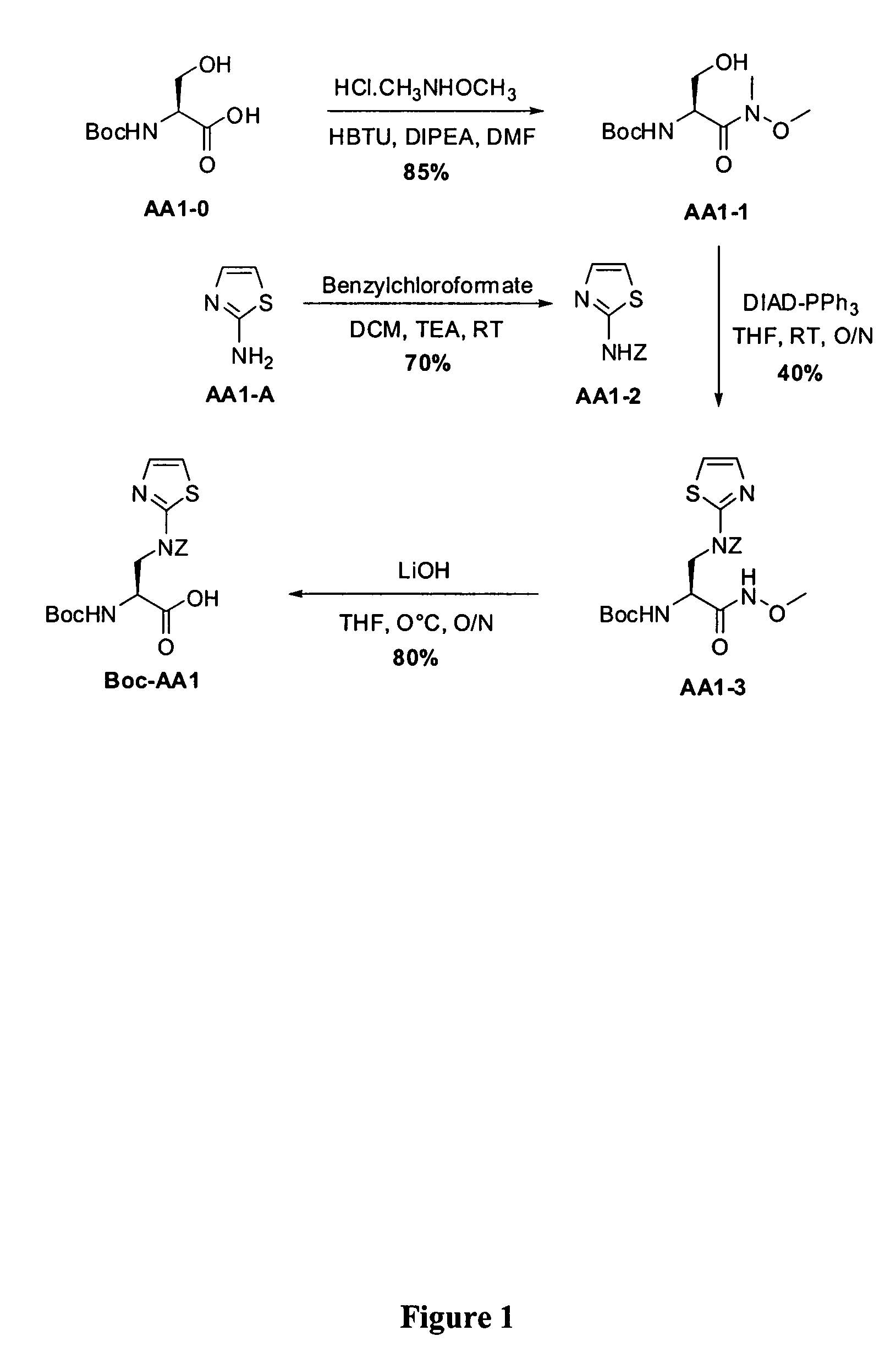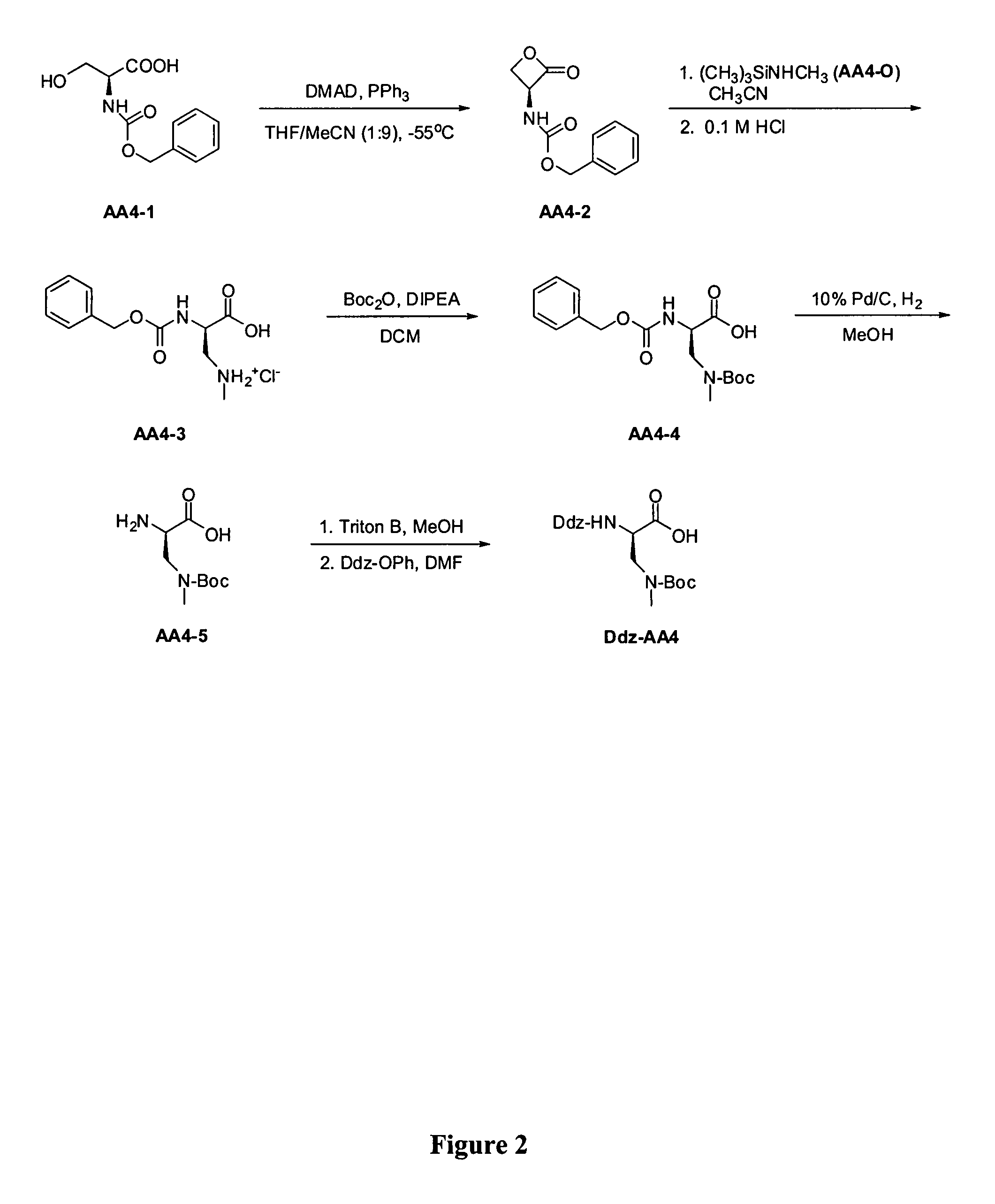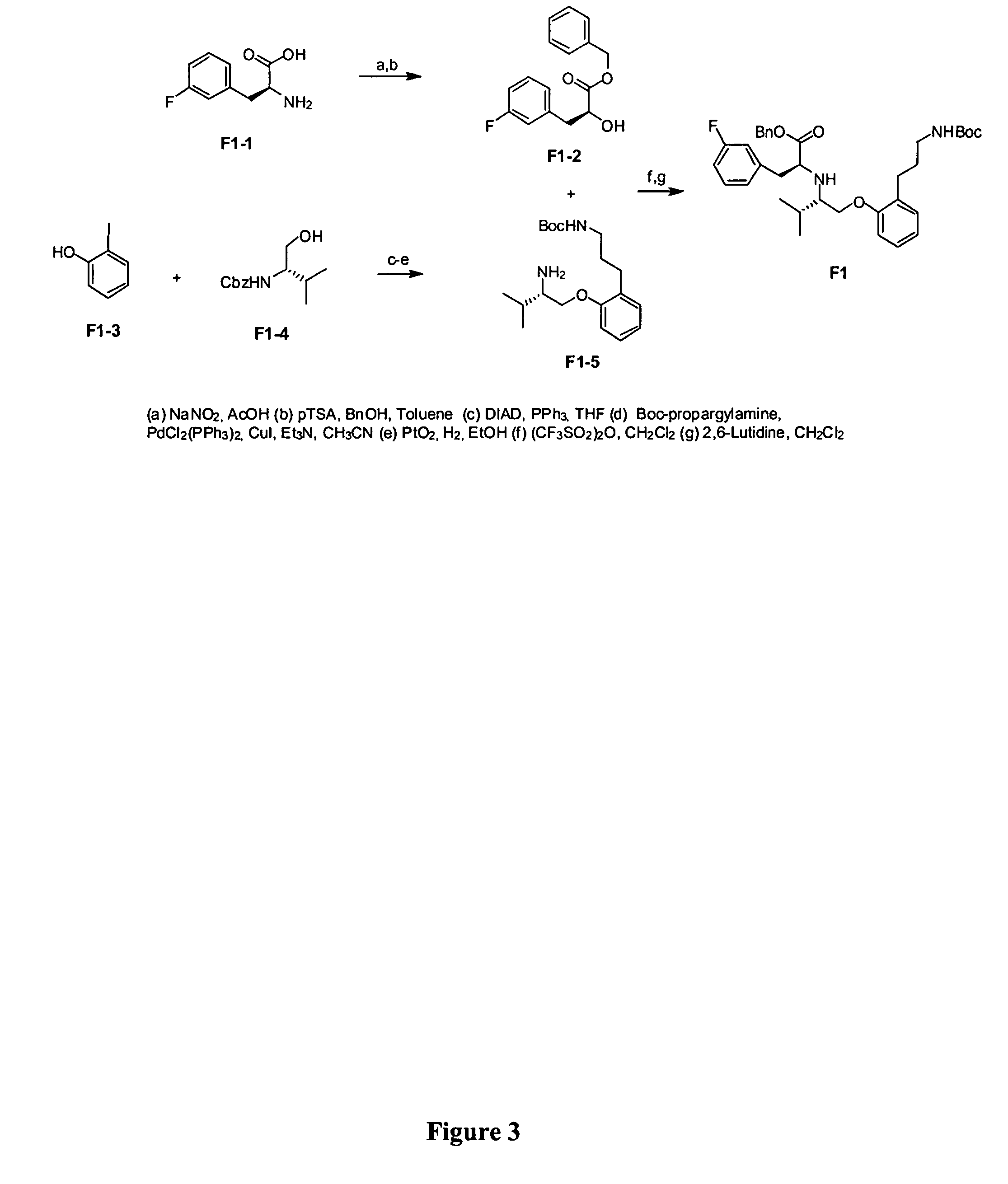Macrocyclic antagonists of the motilin receptor for treatment of gastrointestinal dysmotility disorders
a technology of gastrointestinal dysmotility and macrocyclic antagonists, which is applied in the direction of immunological disorders, metabolism disorders, extracellular fluid disorders, etc., can solve the problems of limited duration, ineffective current treatment of these conditions in many cases, and generally not working in a high percentage of patients, so as to improve the pharmacological
- Summary
- Abstract
- Description
- Claims
- Application Information
AI Technical Summary
Benefits of technology
Problems solved by technology
Method used
Image
Examples
example 1
Standard Procedure for the Synthesis of Boc-Dap(thiazol-2-yl) (Boc-AA1, FIG. 1)
Step 1-1. [2-Hydroxy-1-(methoxy-methyl-carbamoyl)-ethyl]-carbamic acid tert-butyl ester (AA1-1)
[0423]To a solution of Boc-Ser-OH (AA1-0, 3.0 g, 0.015 mol) in DMF (40 mL) was added DIPEA (2.6 mL, 15.0 mmol) and HBTU (5.53 g, 15.0 mmol), then the mixture stirred at room temperature until a homogeneous solution was obtained. N,O-Dimethylhydroxylamine hydrochloride (1.60 g, 16.5 mmol) and DIPEA (2.85 mL, 16.0 mmol) were then added. The solution was stirred at room temperature O / N. The mixture was quenched addition of a saturated aqueous solution of NaHCO3 at 0° C., then extracted with ethyl acetate. The organic phase was dried over Na2SO4 and concentrated under reduced pressure to dryness. Flash chromatography using ethyl acetate as eluent furnished AA1-1 in 85% yield.
[0424]TLC (100% ethyl acetate): Rf=0.40 (CMA).
Step 1-2. Thiazol-2-yl-carbamic acid benzyl ester (AA1-2)
[0425]To a stirred solution of 2-aminoth...
example 2
Standard Procedure for the Synthesis of Boc-Imidazol-1-yl-Ala (AA2)
[0432]
Step 2-1. Boc-Serine-β-lactone (AA2-1)
[0433]This procedure is based on that found in the literature (Vederas, J. C.; et al. J. Am. Chem. Soc. 1987, 109, 4649-4659). Into a dry 250 mL 3-neck flask equipped with a mechanical stirrer under a nitrogen atmosphere was added triphenylphosphine (4.5 g, 17.1 mmol, 1.1 eq), followed by 100 mL of an anhydrous THF:CH3CN (1:9) mixture. The mixture was stirred until a solution was obtained, then cooled to −55° C. (bath temperature) and dimethylazodicarboxylate (DMAD, 1.9 mL, 17.1 mmol, 1.1 eq) added dropwise over 10 min. After the addition, the mixture was stirred for 20 min and a solution of Boc-Ser-OH (3.18 g, 15.5 mmol, 1.0 eq.) in 50 mL of anhydrous THF:CH3CN (1:9) was added dropwise over 30 min. The mixture was stirred at −55° C. for 1.5 h, then the bath was removed and the solution allowed to warm slowly to room temperature. Once the mixture reached room temperature, t...
example 3
Standard Procedure for the Synthesis of Boc-Pyrazol-1-yl-Ala (AA3)
[0440]
[0441]The procedure is based on that described in the literature (Vederas, J. C.; et al. J. Am. Chem. Soc. 1985, 107, 7105-7109). Pyrazole (0.80 g, 11.5 mmol, 1.5 eq) in dry CH3CN (10 mL) was treated dropwise over 5 min with lactone AA3-1 (synthesized as described previously, 0.50 g, 2.67 mmol, 1.0 eq) in dry CH3CN (10 mL) under argon and the resulting mixture stirred for 12 h at 50° C. The reaction was then concentrated to dryness under reduced pressure and the crude residue purified by flash chromatography (ethyl acetate:methanol, 8:2) to give 1.0 g (60% yield) of AA3 as a white solid.
[0442]TLC (ethyl acetate:methanol, 8:2): Rf=0.30 (CMA);
[0443]LC-MS (Grad_A4): tR=5.14 min; mass calculated for C11H17N3O4: 255.2704, found: 255.
PUM
| Property | Measurement | Unit |
|---|---|---|
| thickness | aaaaa | aaaaa |
| pressure | aaaaa | aaaaa |
| pressure | aaaaa | aaaaa |
Abstract
Description
Claims
Application Information
 Login to View More
Login to View More - R&D
- Intellectual Property
- Life Sciences
- Materials
- Tech Scout
- Unparalleled Data Quality
- Higher Quality Content
- 60% Fewer Hallucinations
Browse by: Latest US Patents, China's latest patents, Technical Efficacy Thesaurus, Application Domain, Technology Topic, Popular Technical Reports.
© 2025 PatSnap. All rights reserved.Legal|Privacy policy|Modern Slavery Act Transparency Statement|Sitemap|About US| Contact US: help@patsnap.com



